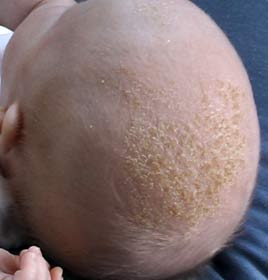Baby Cradle Cap Treatment
Healing and curing your baby of cradle cap
Baby cradle cap treatment is partly determined by the correct diagnosis of cradle cap. Contrary to popular belief, there are three main types of cradle cap, and hence three different types of baby cradle cap treatments to be considered as a result.
 |
To make matters even more interesting, baby cradle cap can change from one type to another, and if the baby cradle cap treatment is particuarly bad, the baby cradle cap can turn into eczema proper, which is a much worse condition. So, as a parent, you really need to to make sure your baby cradle cap treatment is a good one, and appropriate for the type of baby cradle cap your infant has. The terms "baby cradle cap" and "baby cradle cap treatment" are used, to distinguish them from the cradle cap experienced by teenagers and adults. Yes, teenagers and adults can also come down with cradle cap - revolving round maturation and hormones for the most part - essentially the same cradle cap condition, but different causes, different ages, and hence different cradle cap treatments would be required. Baby cradle cap photo on left can be found on wikipedia, along with its licensing terms. |

So what is baby cradle cap?
Baby cradle cap is a mostly temporary malfunction of the sebaceous glands on the babies scalp, face and other parts. Cradle cap is actually a colloquial term based on the infant being of cradle age (baby) and it affects the cap (hat) area of the baby - hence cradle cap. Two forms of cradle cap are classed medically as SEBORRHEA related to steatorrhea or stearrhea or acne sebacea or ichthyosis sebacea. While the third form of cradle cap is medically referred to as seborrhoica dermatitis, which is related to eczema seborrhoicum or seborrhœa corporis (some cases) or pityriasis capitis.
Baby Cradle Cap Definition. Simply put, the fat-producing glands overproduce, producing a secretion on the skin of fatty matter. Cradle cap appears on the skin as an oily coating, scales, or crust. At one point cradle cap was called milk crust, as it was believed the mothers milk caused cradle cap.
Working out the type of cradle cap that your baby has is easyBaby Cradle Cap Symptoms and Types.As mentioned earlier, baby cradle cap is denoted as having three main types: The first type of cradle cap has the symptom of excessive oiliness without inflamation or anything else - medically called seborrhoea oleosa. The second, common colloquial type of cradle cap, is when the oiliness occurs with crust or scale formation only (the over produced oil is more solid on the skin surface, and can often be soaked off or eased off) - medically called seborrhoea sicca (sicca means dry, and refers to the scales and crust component). The third type of baby cradle cap is excessive oiliness + crust or scale + inflammation (redness), and is medically known as seborrhoica dermatitis A possible fourth type of baby cradle cap is when the inflammation becomes most severe and converts to eczema |
Baby cradle cap is a symptom in itself, so idenitfying it is mostly easy for you to do
Essentially if your baby has what looks like thickened areas on the scalp, with whitish lines running and criss-crossing the thickened areas, you have the strick definition of cradle cap. Baby cradle cap was also also referred to as honeycomb disease, because of this appearance - a sort of 2 dimensional honeycomb appearance.
For baby cradle cap proper - without inflammation - the baby cradle cap treatment is normally gently washing the affected area and softening the hardened fats so that they can be easily wiped or peeled off. With this baby cradle cap treatment, it is vitally important not to aggravate the affected skin, as doing so may cause inflammation and worsen the the babies situation.
I've also read that if your baby has eczema, and the baby cradle cap is present, it will still be called baby cradle cap, even though the baby cradle cap treatment would most likely be based on the baby's eczema. In other words, even gentle soap may be out of the question - for this you need professional advice based on the level of the eczema.
Likewise for the seborrhoica dermatitis, the baby cradle cap treatment would be more based on the dermatitis, and the baby cradle cap treatment would be best supervised by medical professionals, as gentle cleaners may not be suitable to remove the baby cradle cap.
Why do other sites talk of cradle cap as being just a singular condition?
It's the theoretical orientation. I am using an older style of classification system that existed before the internet, whereas the other internet sites are using a different definition that sees cradle cap purely as a type of dermatitis. What's the point? Well, I believe the older classification system to be the better one. Does it alter how you would treat your baby? Possibly, as the classification system I use, I believe gives you more options, more understanding - but that is just my opinion in relation to cradle cap and it's treatment.
ABOUT THE AUTHOR: Donald Urquhart, Psychologist and editor, enjoys medical and related writing.
If you want to come back to www.BabyCradleCapTreatment.com again, please add BabyCradleCapTreatment.com to your bookmarks or favorites now, otherwise you'll forget like everyone does! Please also remember,www.BabyCradleCapTreatment.com, like all our web sites, is an educational one. BabyCradleCapTreatment.com is NOT designed to diagnose nor treat but to offer understanding, ideas and options for you to discuss with your doctor. Our Privacy Policy can be found at www.cholesterolcholestrol.com/privacypolicy.htm Copyright © 2000-present Donald Urquhart. All Rights Reserved. Designated trademarks and brands are the property of their respective owners. Use of BabyCradleCapTreatment.com constitutes acceptance of our legal disclaimer.
| ABOUT US | CONTACT US |
